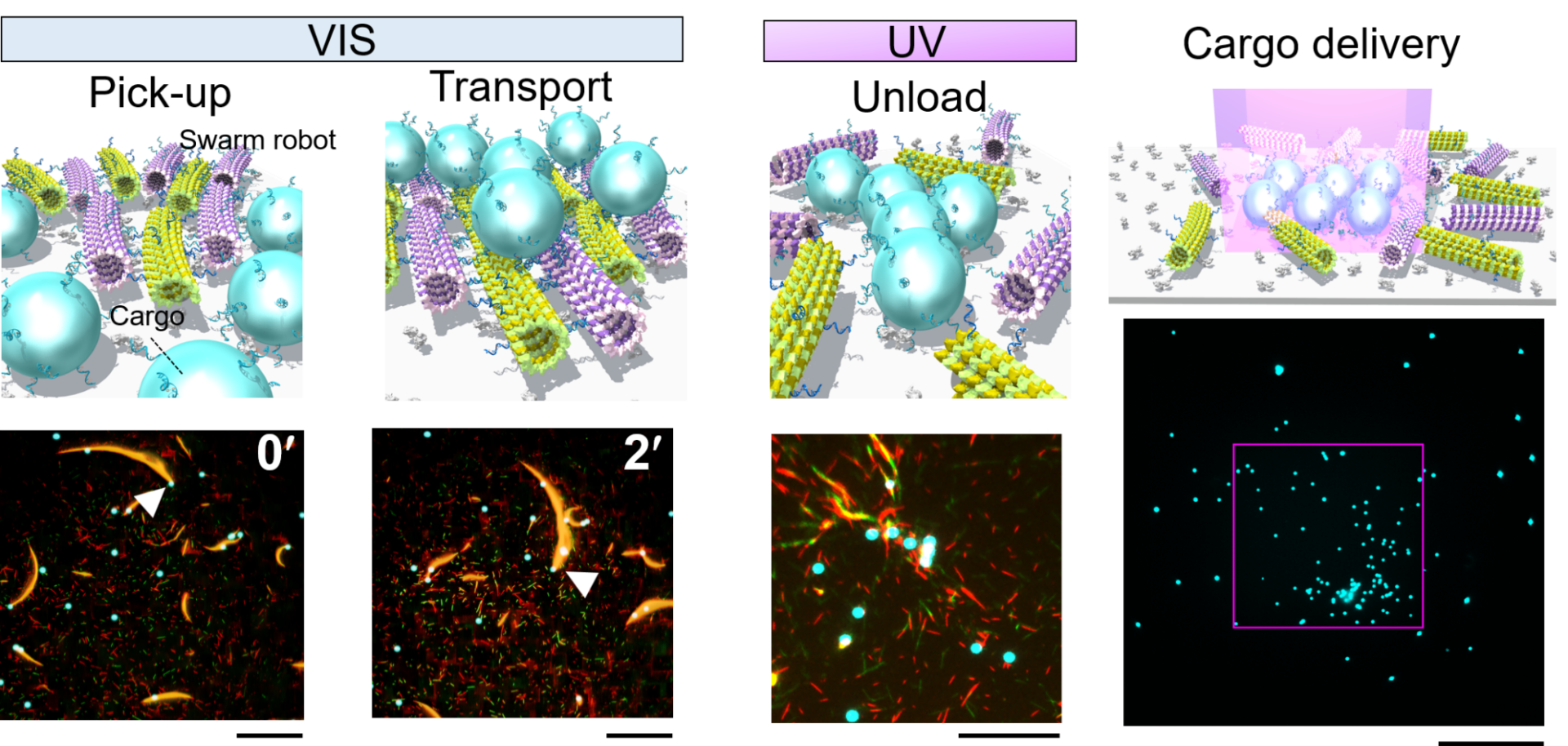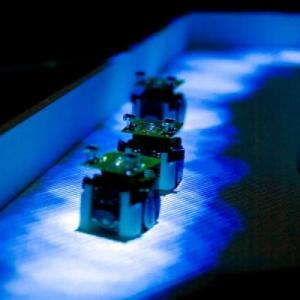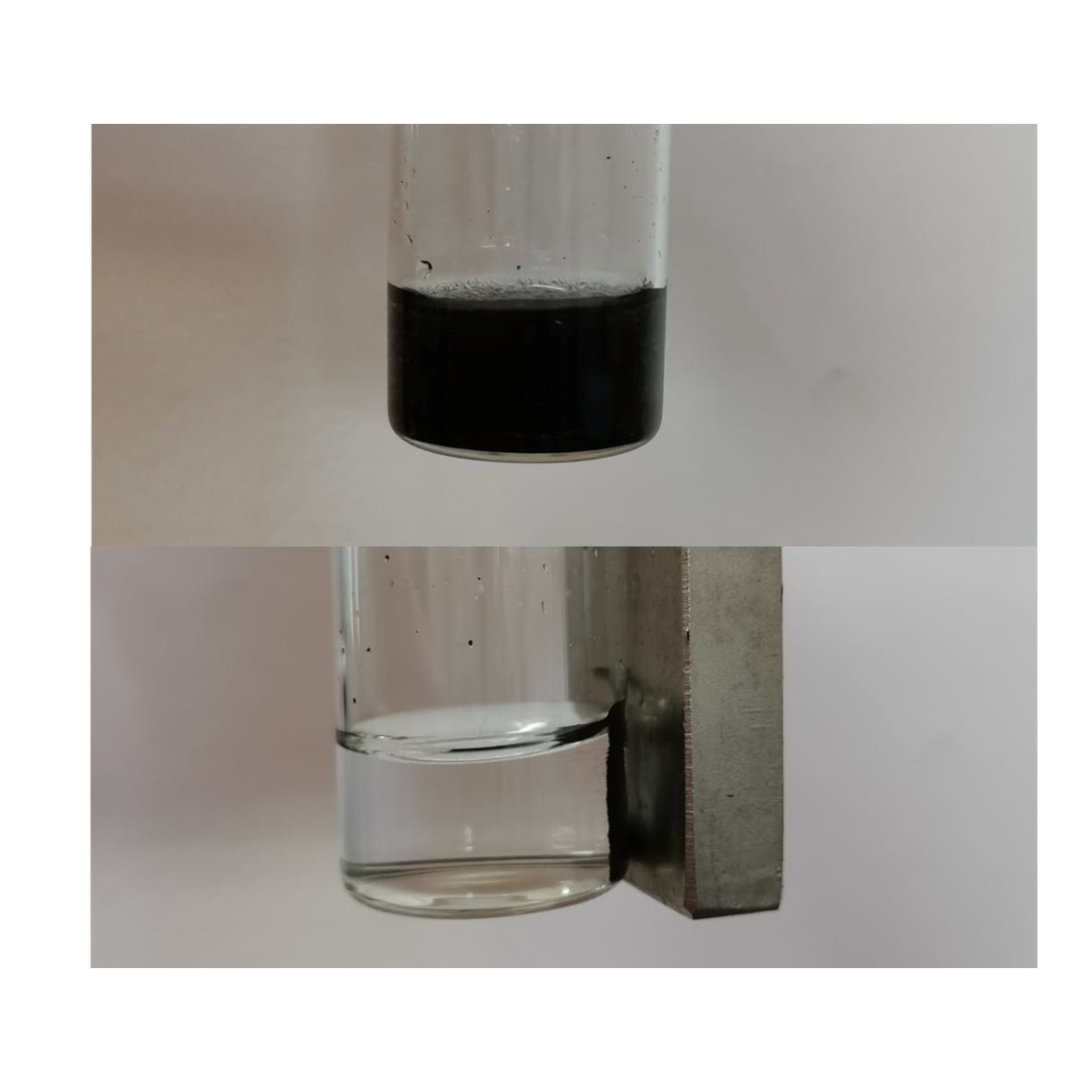
Schematic illustrations of cargo transport by a swarm of molecular robots (top) and fluorescence images of a molecular robot transporting blue sphere-like cargo (bottom). The scale bar is 20 micrometers. By specifying the position of the light irradiation, it is possible to accumulate the cargo at the designated destination (right). The scale bar is 50 micrometers
(Mousumi Akter, et al. Science Robotics. April 20, 2022).
In a global first, scientists have demonstrated that molecular robots are able to accomplish cargo delivery by employing a strategy of swarming, achieving a transport efficiency five times greater than that of single robots.
Different diameters of cargo loading and transport by single and swarm transporters. Scale bar: 20 µm. The diameter of the cargo (d) is mentioned on the top left of each movie. Here, the swarms could load and transport cargoes with diameters up to 20.0 µm, whereas the single transporters failed to load and transport cargoes with a diameter larger than 3.4 µm. The movie is played at 100 times the speed of the original (Mousumi Akter, et al. Science Robotics. April 20, 2022).
Swarm robotics is a new discipline, inspired by the cooperative behavior of living organisms, that focuses on the fabrication of robots and their utilization in swarms to accomplish complex tasks. A swarm is an orderly collective behavior of multiple individuals. Macro-scale swarm robots have been developed and employed for a variety of applications, such as transporting and accumulating cargo, forming shapes, and building complex structures.
A team of researchers, led by Dr. Mousumi Akter and Associate Professor Akira Kakugo from the Faculty of Science at Hokkaido University, has succeeded in developing the world’s first working micro-sized machines utilizing the advantages of swarming. The findings were published in the journal Science Robotics. The team included Assistant Professor Daisuke Inoue, Kyushu University; Professor Henry Hess, Columbia University; Professor Hiroyuki Asanuma, Nagoya University; and Professor Akinori Kuzuya, Kansai University.
A swarm of cooperating robots gains a number of characteristics which are not found in individual robots—they can divide a workload, respond to risks, and even create complex structures in response to changes in the environment. Microrobots and machines at the micro- and nano-scale have very few practical applications due to their size; if they could cooperate in swarms, their potential uses would increase massively.
Cooperative task achievement by swarm transporters through loading and transporting cargo over a long distance. Scale bar: 20 µm. Here, the swarm-loaded cargo traveled a total distance of 1 mm without falling off under VIS irradiation. The movie is played at 100 times the speed of the original (Mousumi Akter, et al. Science Robotics. April 20, 2022).
Cargo unloading from the group of transporters under UV irradiation. Scale bar: 20 µm. Here, dissociation of the swarm transporter into single microtubules and cargo unloading from the transporters were observed to occur simultaneously. The unloaded cargoes remained stationary and were no longer transported under UV light irradiation. The movie is played at 100 times the speed of the original (Mousumi Akter, et al. Science Robotics. April 20, 2022).
The team constructed about five million single molecular machines. These machines were composed of two biological components: microtubules linked to DNA, which allowed them to swarm; and kinesin, which were actuators capable of transporting the microtubules. The DNA was combined with a light-sensitive compound called azobenzene that functioned as a sensor, allowing for control of swarming. When exposed to visible light, changes in the structure of azobenzene caused the DNA to form double strands and led to the microtubules forming swarms. Exposure to UV light reversed this process.
The cargo used in the experiments consisted of polystyrene beads of diameters ranging from micrometers to tens of micrometers. These beads were treated with azobenzene-linked DNA; thus, the cargo was loaded when exposed to visible light and unloaded when exposed to UV light. However, the DNA and azobenzene used in the molecular machines and the cargo were different, so swarming could be controlled independently of cargo-loading.
Single machines are able to load and transport polystyrene beads up to 3 micrometers in diameter, whereas swarms of machines could transport cargo as large as 30 micrometers in diameter. Furthermore, a comparison of transport distance and transport volume showed that the swarms were up to five times more efficient at transport compared to the single machines.
By demonstrating that molecular machines can be designed to swarm and cooperate to transport cargo with high efficiency, this study has laid the groundwork for the application of microrobots to various fields. “In the near future, we expect to see microrobot swarms used in drug delivery, contaminant collection, molecular power generation devices, and micro-detection devices,” says Akira Kakugo.
Original Article: Molecular robots work cooperatively in swarms
More from: Hokkaido University | Kyushu University | Columbia University | Nagoya University | Kansai University
The Latest Updates from Bing News & Google News
Go deeper with Bing News on:
Swarming molecular robots
- Tesseract Ventures Announces Revolutionary SWARM Drone Technology for Special Operations Forces
OVERLAND PARK, Kan., April 30, 2024 /PRNewswire/ -- Tesseract Ventures is excited to announce that it has been awarded an Other Transaction Agreement (OTA) from the U.S. Special Operations Command ...
- Festo unveils miniature robot bees that can navigate swarm flight
Festo, the master in developing bionic flying objects, has unveiled ultra-light, delicately designed robotic bees. Named BionicBee, it is part of the German automation company’s Bionic Learning ...
- Robot bee swarms fly collision-free in close formation
We've seen some impressive nature-inspired flying bots from the creative minds at Festo's Bionic Learning Network over the years, but the autonomous BionicBee is not only the smallest so far but also ...
- A six-armed robot for precision pollination
Over the past decades, dozens of animal species have become extinct, while thousands of others are now at risk of disappearing. Endangered species include various pollinators, including bees and some ...
- Bee Swarm Simulator codes April 2024
April 28, 2024: We’re still looking for new Bee Swarm Simulator codes for Spring. What are the active Bee Swarm Simulator codes? Whether you’re in the market for some free items to help you ...
Go deeper with Google Headlines on:
Swarming molecular robots
[google_news title=”” keyword=”swarming molecular robots” num_posts=”5″ blurb_length=”0″ show_thumb=”left”]
Go deeper with Bing News on:
Molecular robots
- FDA-approved surgical robots trend toward autonomy, study finds
A systematic review in npj Digital Medicine categorizes FDA-approved surgical robots by their levels of autonomy, highlighting a need for standardized definitions and greater regulatory clarity as ...
- Automated machine learning robot unlocks new potential for genetics research
University of Minnesota Twin Cities researchers have constructed a robot that uses machine learning to fully automate a complicated microinjection process used in genetic research.
- Automated machine learning robot unlocks new potential for genetics research
MINNEAPOLIS/ST. PAUL (04/26/2024) — University of Minnesota Twin Cities researchers have constructed a robot that uses machine learning to fully automate a complicated microinjection process ...
- Automated machine learning robot unlocks new potential for genetics research
Researchers have constructed a robot that uses machine learning to fully automate a complicated microinjection process used in genetic research. University of Minnesota Twin Cities researchers ...
- Enter Robots: Are We Ready?
The term “robot” suggests a human-like machine—a walking, talking automaton. Robotics is a much broader technology: Assembly robots in factories, warehouse workers, or surgical robots in ...
Go deeper with Google Headlines on:
Molecular robots
[google_news title=”” keyword=”molecular robots” num_posts=”5″ blurb_length=”0″ show_thumb=”left”]










